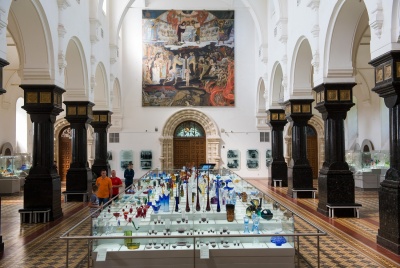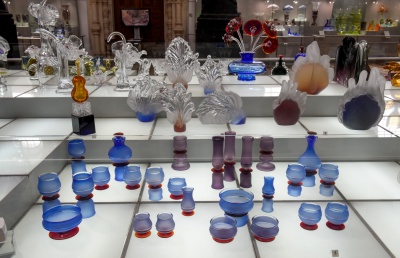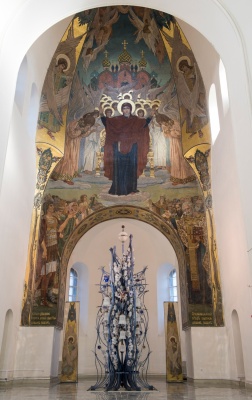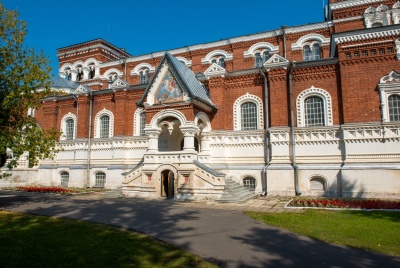Crystal Museum named after Maltsovs
The Crystal Museum named after Maltsovs (part of the Vladimir-Suzdal Museum-Reserve), one of the best museums of Russian art glass, was opened in 1983 in Gus-Khrustalny. It is housed in the building of the former St. George Cathedral (1892-1903) designed by the architect Leonty Benois in pseudo-Russian style. Therefore the decoration of the cathedral was preserved in the interior of the Crystal Museum – the painting "The Last Judgment" by famous Viktor Vasnetsov and the mosaic "Rejoices at You, Gracious" made by the famous mosaic artist V.A. Frolov on the basis of V.M. Vasnetsov’s sketch.
The Crystal Museum named after Maltsovs presents the best works of outstanding Gus artists and craftsmen dating back to the period from the second half of the 18th century to the present day. The contemporary collection of the Crystal Museum has at least 2 thousand exhibits of amazing beauty.
The basis of the museum’s collection consists of crystal products created at the legendary crystal factory (founded in 1756 by Akim Maltsov) which determined the origin and development of the city of Gus-Khrustalny. At all times of its existence the factory has been manufacturing products made of clear-cut glass which were famous not only in Russia but also abroad.
Back in the 18th century the enterprise started a tradition of collecting the best samples of its products. Certainly, after all this time, the works of many skilled glass masters (I. Prokofyev, M. Ignatyev, E. Mikhaylov, I. Danilov, etc.) were lost. But the expositions of the Crystal Museum today carefully preserve the works of glass artists with a 200-year history and are enriched with new products.
Many works of crystal art craft presented in the museum reflect the historical path of the country. For example, in the decor of products of the first quarter of the 20th century revolutionary symbolism was observed. Products of the 1920s are simple and laconic in shape with a decor in the form of ordinary engraving and painting with colored paints. In the years of the first five-year plans the themes "Five-year plan for 4 years", "20 years of October", etc. appeared in the design of crystal items. Even during the Great Patriotic war the Gus Crystal Plant did not stop its activity, but it produced objects demanded at the front – medical ampoules, thermoses, flasks, technical glass, – rather than highly artistic products. Only in 1948 the plant resumed the production of crystal.
The Crystal Museum contains unique works crafted by famous glass artists of the Soviet era – People's Artists of the Russian Federation E.I. Rogov, V.S. Muratov, V.V. Korneyev, A.S. Kurilov, Honored Artist of the Russian Federation O.I. Kozlova and others.
Studying the trends and fields of the world art of glass-making, contemporary artists strive to discover new expressive means, their own way in the design of glass. The work on the image of an artistic thing is carried out in two fields – the creation of unique, author's products, as well as standards of mass production. Many glass and crystal works of art were displayed at international, All-Union and Russian exhibitions and gained well-deserved rewards.
The excursion at the Crystal Museum is always accompanied with quiet classical music which facilitates the visitors’ emotional perception of this crystal wealth and beauty.



